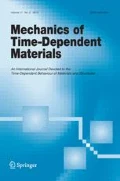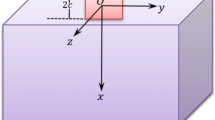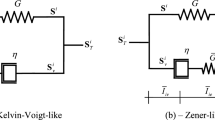Abstract
Visco-elastic materials are known for their capability of dissipating energy. This energy is converted into heat and thus changes the temperature of the materials. In addition to the dissipation effect, an external thermal stimulus can also alter the temperature in a visco-elastic body. The rate of stress relaxation (or the rate of creep) and the mechanical and physical properties of visco-elastic materials, such as polymers, vary with temperature. This study aims at understanding the effect of coupling between the thermal and mechanical response that is attributed to the dissipation of energy, heat conduction, and temperature-dependent material parameters on the overall response of visco-elastic solids. The non-linearly visco-elastic constitutive model proposed by Schapery (Further development of a thermodynamic constitutive theory: stress formulation, 1969, Mech. Time-Depend. Mater. 1:209–240, 1997) is used and modified to incorporate temperature- and stress-dependent material properties. This study also formulates a non-linear energy equation along with a dissipation function based on the Gibbs potential of Schapery (Mech. Time-Depend. Mater. 1:209–240, 1997). A numerical algorithm is formulated for analyzing a fully coupled thermo-visco-elastic response and implemented it in a general finite-element (FE) code. The non-linear stress- and temperature-dependent material parameters are found to have significant effects on the coupled thermo-visco-elastic response of polymers considered in this study. In order to obtain a realistic temperature field within the polymer visco-elastic bodies undergoing a non-uniform heat generation, the role of heat conduction cannot be ignored.















Similar content being viewed by others
Notes
The nonlinearity in this context is attributed to stress (or strain) and temperature-dependent material parameters in that the proportionality and superposition conditions in the viscoelastic response of polymers are no longer applicable.
Since the temperature and stress/deformation are spatially dependent and alter the properties of the polymer, the polymer that is initially isotropic and homogeneous with regards to its mechanical and transport properties in its unloaded state may become anisotropic and heterogeneous due to the non-uniform stress and temperature fields of the polymer body.
With an analogy to a linear elastic case, the idea of Poisson’s ratio for linearly viscoelastic materials has been used which results in different values of time-dependent Poisson’s ratio for different testing procedures: creep, relaxation, dynamics frequency tests (see Lakes and Wineman 2006). Analytical and experimental studies on Poisson’s ratio for viscoelastic materials, within a correspondence principle to a linear elastic material (Hilton 2001; Lu et al. 1997), suggest that time-dependent Poisson’s ratio has an implication to the time-dependent bulk modulus. Further experimental study by Ravi-Chandar and Ma (2000) showed time-dependent shear and bulk moduli of polymers. Bero and Plazek (1991), Meng and Simon (2007) and Grassia et al. (2010) have shown experimentally that bulk and shear responses arise from similar mechanisms for a shorter time, however, for longer time the long chain relaxation mechanism are only active in shear response. In general, for linearly viscoelastic isotropic materials, the linear elastic correspondence principle would result in time-dependent elastic, shear, bulk moduli and time-dependent Poisson’s ratio (Tschoegl et al. 2002; Lakes and Wineman 2006; Grassia et al. 2010). Fixing one of the above properties to be constant (time-independent) might not necessarily represent a realistic response of the materials. This is done mainly to reduce complexity in analyzing response of viscoelastic materials and/or because unavailability of time-dependent experimental data.
The parametric studies on the convergence behavior for the proposed algorithm under various loading conditions can be found in Khan (2011).
References
ABAQUS: User’s Manual, Version 6.5. Hibbitt, Karlsson and Sorensen Inc., Providence (2005)
Bassiouny, E., Ghaleb, A.F., Maugin, G.A.: Thermodynamical formulation for coupled electromechanical hysteresis effects-I: basic equations. Int. J. Eng. Sci. 26(12), 1279–1295 (1988)
Berardi, G., Jaeger, M., Martin, R.: Finite element modeling of heat transfers in visco-elastic materials for large deformation. Num. Heat Transf. A 32, 37–49 (1997)
Bero, C.A., Plazek, D.J.: Volume-dependent rate processes in an epoxy resin. J. Polym. Sci., Part B, Polym. Phys. 29, 39–47 (1991)
Biot, M.A.: Linear thermodynamics and the mechanics of solids. In: Proc. 3rd. U.S. National Congress of Applied Mechanics, vol. 1 (1958)
Chen, X.: Nonlinear Electro-thermo-visco-elasticity. Acta Mech. 211, 49–59 (2010)
Coleman, B.D.: Thermodynamics of materials with memory. Arch. Ration. Mech. Anal. 17, 1 (1964)
Cost, T.L.: Dissipation of mechanical energy in viscoelastic materials viscoelastic solids. Bulletin of 8th JANNAF Mechanical Behavior Working Group Meeting, CPIA Publication, vol. 193(1), p. 113 (1969a)
Cost, T.L.: Thermomechanical coupling phenomena in non-isothermal viscoelastic solids. Rohm and Haas Company, Huntsville, Alabama, Technical Report. S-226 (1969b)
Cost, T.L.: Thermomechanical coupling phenomena in non-isothermal viscoelastic solids. Ph.D. Thesis, University of Alabama (1969c)
Dillon, O.W. Jr.: An experimental study of the heat generation during torsional oscillations. J. Mech. Phys. Solids 10, 235–244 (1962)
Dillon, O.W. Jr.: Coupled thermoplasticity. J. Mech. Phys. Solids 11, 21 (1963)
Flugge, W.: Viscoelasticity. Springer, New York (1975)
Gibbs, J.W.: A method of geometrical representation of the thermodynamic properties of substances by means of surfaces. Trans. Conn. Acad. II, 382–404 (1873)
Grassia, L., D’Amore, A., Simon, S.L.: On the viscoelastic Poisson’s ratio in amorphous polymers. J. Rheol. 54(5), 1009–1022 (2010)
Helmholtz, H.: On the thermodynamics of chemical processes. In: Physical Memoirs Selected and Translated from Foreign Sources, vol. 1, pp. 43–97 (1882). Physical Society of London, Taylor and Francis (1888)
Hilton, H.H.: Implications and constraints of time-independent Poisson’s ratios in linear isotropic and anisotropic viscoelasticity. J. Elast. 63, 221–251 (2001)
Holzapfel, G.A., Reiter, G.: Fully coupled thermomechanical behaviour of viscoelastic solids treated with finite elements. Int. J. Eng. Sci. 33(7), 1037–1058 (1995)
Huang, N.C., Lee, E.H.: Thermomechanical coupling behavior of viscoelastic rods subjected to cyclic loads. J. Appl. Mech. 34, 127–132 (1967)
Hunter, S.C.: Tentative equations for the propagation of stress, strain, and temperature fields in viscoelastic solids. J. Mech. Phys. Solids 9, 39 (1961)
Johnson, A., Chen, T.K.: Approximating thermo-viscoelastic heating of largely strained solid rubber components. Comput. Methods Appl. Mech. Eng. 194, 313–325 (2005)
Kasti, N.A., Lubliner, J., Taylor, R.L.: A numerical solution for the coupled quasi-static linear thermoelastic problem. J. Therm. Stresses 14(3), 333–349 (1991)
Khan, K.A.: A time integration scheme for stress temperature dependent viscoelastic behaviors of adhesive polymers. M.S. Thesis, Texas A&M University (2006)
Khan, K.A.: A multiscale model for coupled heat conduction and deformations of viscoelastic composites. Ph.D. Thesis, Texas A&M University (2011)
Knauss, W.G., Emri, I.: Volume change and the nonlinearly thermo-viscoelastic constitution of polymers. Polym. Eng. Sci. 27(1), 86–100 (1987)
Lakes, R.S., Wineman, A.: On Poisson’s ratio in linearly viscoelastic solids. J. Elast. 85, 45–63 (2006)
Lim, T.J., McDowell, D.L.: Cyclic thermomechanical behavior of a polycrystalline pseudoelastic shape memory alloy. J. Mech. Phys. Solids 50(3), 651–676 (2002)
Lu, H., Zhang, X., Knauss, W.G.: Uniaxial, shear, and Poisson relaxation and their conversion to bulk relaxation. Polym. Compos. 18, 211–222 (1997)
Medri, G.: Coupled thermoviscoelasticity: a way to the stress-strain analysis of polymeric industrial components. Meccanica 23(4), 226–231 (1988)
Meng, Y., Simon, S.L.: Pressure relaxation of polystyrene and its comparison to the shear response. J. Polym. Sci., Part B, Polym. Phys. 45, 3375–3385 (2007)
Muliana, A.H., Khan, K.A.: A time-integration algorithm for thermorheologically complex polymers. Comput. Mater. Sci. 41(4), 576–588 (2008)
Oden, J.T., Armstrong, W.H.: Analysis of nonlinear dynamics coupled thermoviscoelasticity problems by the finite element method. Comput. Struct. 1, 603–621 (1971)
Oden, J.T., Kauss, D.A.: Analysis of general coupled thermoelasticity problems by the finite element method. In: Berke, L., et al. (eds.) Proc., 2nd Conf.: Matrix Methods in Structural Mechanics, Wright-Patterson AFB, Ohio (1968). AFFDL-TR-68-150
Parkus, H.: Grundlagen and probleme der thermo and thcrmoviskoelastizitat. Z. Angew. Math. Mech. 46, T16–T24 (1966)
Peretz, D., Weitsman, Y.: Nonlinear viscoelastic characterization of FM73 adhesives. J. Rheol. 26(3), 245–261 (1982)
Peretz, D., Weitsman, Y.: The nonlinear thermoviscoelastic characterization of FM73 adhesives. J. Rheol. 27(2), 97–114 (1983)
Rajagopal, K.R., Srinivasa, A.R.: A Gibbs-potential-based formulation for obtaining the response functions for a class of viscoelastic materials. Proc. R. Soc. A 467(2125), 39–58 (2011)
Ravi-Chandar, K., Ma, Z.: Inelastic deformation in polymers under multiaxial compression. Mech. Time-Depend. Mater. 4, 333–357 (2000)
Reddy, J.N.: An Introduction to Continuum Mechanics: With Applications. Cambridge University Press, New York (2008)
Reese, S., Wriggers, P.: Thermo-viscoelastic material behaviors at finite deformations with temperature-dependent material parameters. Z. Angew. Math. Mech. 78, S157 (1998)
Schapery, R.A.: Thermomechanical behavior of viscoelastic media with variable properties subject to cyclic loading. J. Appl. Mech. 32, 611–619 (1965)
Schapery, R.A.: A theory of non-linear thermoviscoelasticity based on irreversible thermodynamics. In: Proc, pp. 511–530. ASME, University of Minnesota (1966)
Schapery, R.A.: Further development of a thermodynamic constitutive theory: stress formulation. Purdue University Report No. AA & ES. 692, (1969)
Schapery, R.A.: Nonlinear viscoelastic and viscoplastic constitutive equations based on thermodynamics. Mech. Time-Depend. Mater. 1, 209–240 (1997)
Schapery, R.A., Cantey, D.E.: Thermomechanical response studies of solid propellants subjected to cyclic and random loadings. AIAA J. 4(2), 255–264 (1966)
Schwarzl, F., Staverman, A.J.: Time temperature dependence of linear viscoelastic behavior. J. Appl. Phys. 23, 838 (1952)
Tauchert, T.R.: The temperature generated during torsional oscillation of polyethylene rods. Int. J. Eng. Sci. 5, 353–365 (1967a)
Tauchert, T.R.: Heat generation in a viscoelastic solid. Acta Mech. 3(4), 385–396 (1967b)
Tauchert, T.R.: Transient temperature distributions in viscoelastic solids subject to cyclic deformations. Acta Mech. 6, 239–252 (1968)
Tauchert, T.R., Afzal, S.M.: Heat generated during torsional oscillations of polymethylmethacrylate tubes. J. Appl. Phys. 38(12), 4568–4572 (1967)
Truesdell, C., Noll, W.: The Nonlinear Field Theories of Mechanics. Encyclopedia of Physics III/l. Springer, New York (1965). Edited by S. Flugge
Tschoegl, N.W., Knauss, W.G., Emri, I.: Poisson’s ratio in linear viscoelasticity—a critical review. Mech. Time-Depend. Mater. 6, 3–51 (2002)
Wineman, A.S., Rajagopal, K.R.: Mechanical Responses of Polymers: An Introduction. Cambridge University Press, London (2001)
Wolosewick, R.M., Gratch, J.: Transient response in a viscoelastic material with temperature dependent properties and thermomechanical coupling. Appl. Mech. 32, 620–622 (1965)
Acknowledgement
This research is supported by Air Force Office of Scientific Research (AFOSR) under grant FA 9550-10-1-0002.
Author information
Authors and Affiliations
Corresponding author
Appendices
Appendix A
In this study, using the Gibbs free energy potential that was originally introduced by Schapery (1997) the dissipation function and energy equation for fully coupled non-linearly thermo-visco-elastic analyses are formulated. Explicit expressions also are derived for the mechanical dissipation rate, the rate of change of entropy and specific heat at constant stress, respectively. In deriving the basic constitutive relations the similar notions that were introduced by Schapery (1997) are used. Detail derivation of the constitutive and energy equations can be found in Khan (2011).
Schapery (1997) introduced Gibbs free energy in terms of stresses (σ i ) and internal state variables (ISVs) ζ m and temperature T. The Gibbs free energy for a non-linearly thermo-visco-elastic material can be expressed in the following form:
where G 0,A m and B mn are function of σ i and T. The strain, after neglecting terms of second order in ζ m , can be obtained from the following equation (Schapery 1969, 1997):
The expression for ζ m according to Schapery (1969, 1997) is
where C m and λ m are the constant and inverse of positive retardation time, respectively. The a 2 is a positive scalar quantity that could be a function of σ i and T. The term ψ τ is a function of time τ, time at which the input load is applied. The variable ψ t is the reduce time. To facilitate the characterization in terms of master creep functions through reduce time, A m is given as
where C mn and α m are constants. \(\hat{\sigma}_{n}\) depend on σ i and T and \(\hat{\phi}\) may depend on temperature but not on stress. \(\hat{\phi}\) accounts for the thermal expansion effect; thus \(\hat{\phi} = 0\) when T=T R (reference temperature). Substituting of A m into Eq. (A.3), neglecting the transient components of thermal expansion coefficients and after some simplification, we can write Eq. (A.2) as
where dD nk (ψ t) represents the transient components of the mechanical creep compliances:
Schapery (1969) derived an expression for strain response due to uniform uniaxial state of stress (\(\hat{\sigma} = \sigma\)) under an isothermal condition and introduce non-linear parameters to incorporate the contribution of higher orders terms of the Gibbs free energy in terms of the applied stresses. Under isothermal conditions, the uniaxial strain using Eq. (A.5) can be expressed:
where g o ,g 1,g 2 are the non-linear parameters that depend on the stress (σ t). D 0 and dD are the instantaneous elastic and transient creep compliances, respectively. The Schapery (1969) model has been extended to a three-dimensional model and modified to incorporate the dependence of temperature and stress on the mechanical properties (Khan 2006), which is

The non-linear parameters depend on the current temperature T and effective stress (\(\bar{\sigma}^{t}\)).
Combining the first and second law of thermodynamics, the following expression for the energy balance in thermovisco-elastic materials is established (Rajagopal and Srinivasa 2011):
where \(\dot{\eta}\) is the rate of entropy. The heat generation rate \(T\dot{\gamma}_{\mathrm{int}} = f_{m}\dot{\zeta}_{m} \ge 0\) is always positive unless ζ m =0. The expression for thermodynamic forces from the Gibbs energy in (A.1) is \(f_{m} = -\frac{\partial G}{\partial \zeta_{m}} = A_{m} -B_{mn}\zeta_{n}\). The indices of m and n can be associated to the each component of spring and dashpot in a mechanical analog representation (Schapery 1997). Using the above thermodynamic forces and assuming B m =a 2 C m , the entropy production is
Substituting A m and ζ m from Eq. (A.4) and Eq. (A.3), respectively, the heat generation rate can be expressed in terms of engineering stress (\(\sigma_{ij}^{t}\)) as follows:

For isotropic materials, the thermo-elastic Gibbs potential (G 0) in Eq. (A.1) is assumed to have the following form:
where θ t=T t−T 0,T 0 is the reference temperature. Here \(C_{\mathrm{th}}, \alpha(T^{t}),D_{ijkl}^{(0)}\) are the thermal part of the thermo-elastic Gibbs free energy, temperature-dependent coefficient of linear thermal expansion and isotropic elastic compliance, respectively. The left-hand side of Eq. (A.9) can be found using Eq. (A.1) and Eq. (A.12) as

The specific heat capacity is defined as
The specific heat can also be defined using the internal energy \(\mathcal{E}\), i.e.,
Substituting Eq. (A.1) into Eq. (A.14) and using Eq. (A.12), the expression for specific heat at a constant stress is

The energy equation from Eqs. (A.11) and (A.13) which incorporates visco-elastic dissipation and stress- and temperature-dependent material parameters and thermo-elastic coupling becomes

where C th in Eq. (A.13) is assumed such that it accounts for the temperature-dependent specific heat at a constant stress. The above equation can be reduced for a linearly visco-elastic material as

Appendix B
This Appendix presents the analytical solutions for strain and temperature evolution in a linearly visco-elastic material under a creep. The standard linear solid (SLS) and Boltzmann integral models are considered (see Flugge 1975, Wineman and Rajagopal 2001, Reddy 2008).
Under a pure shear loading, the governing differential equation for the SLS model is
An instantaneous constant shear stress of magnitude τ 1 is applied at time t=0:σ 12(t)=τ 1 H(t), where H(t) is a Heaviside function. The expression for time dependent strain is
The energy equation under an adiabatic process and no internal heating source, \(\rho c_{\sigma} \dot{T} = \dot{w}_{\mathrm{dis}}^{t}\), is
Substituting the expressions of ε 12(t) and σ 12(t) and solving Eq. (B.3) using the initial condition T(0)=0, we can determine the expression for the evolution of temperature:

where δ(t) is the Dirac delta function.
Under a general stress history the shear strain is expressed as
Here J 0 and dJ(t) are the shear instantaneous elastic and transient compliances. The transient creep compliance with N arrangements of springs and dashpots is expressed as
where J n and λ n are Prony coefficients and retardation times, respectively. With one Prony coefficient, the integral model is equivalent to the SLS model. The energy equation (Appendix A), assuming an adiabatic process and no internal heating source, for an isotropic linearly visco-elastic material can be expressed as
Using general stress history σ 12(t) and creep compliance dJ(t), solving Eq. (B.7), and satisfying initial condition the evolution of temperature can be obtained.
Rights and permissions
About this article
Cite this article
Khan, K.A., Muliana, A.H. Fully coupled heat conduction and deformation analyses of visco-elastic solids. Mech Time-Depend Mater 16, 461–489 (2012). https://doi.org/10.1007/s11043-012-9172-2
Received:
Accepted:
Published:
Issue Date:
DOI: https://doi.org/10.1007/s11043-012-9172-2




